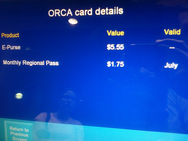Seattle’s ORCA passes show what Metro passes could be

Photo by IOst2 on Flickr.
WMATA should replace its existing three-pass system for weekly Metrobus and Metrorail riders with a flexible pass system modeled off of Puget Pass.
Puget Pass is a system in the Seattle area where riders pay a fixed monthly price based on the value of the trip they want to have included. For rides that exceeed their price, they have to pay extra out of stored value.
I obtained data from Sound Transit’s press office about the Puget Pass program and their version of Smartrip, called ORCA (“one regional card for all”).
ORCA is usable on seven different transit agencies in the Seattle area. It’s accepted on everything from local/express buses to light rail; from ferries to commuter rail. The Puget Pass is one of the many passes available on ORCA. It’s promoted by all the regional transit agencies, and sold at a price of 36 times the one-way value for a month. Many employers purchase Puget Pass for their employees.
Seattle regional transit is similar to Metro because there are many different fares offered, some distance based (by zone), some by time of day and others by age category. The Sound Transit express buses have a zone fare system, with three potential fare levels. King County buses have three adult fare levels based on time of day and on number of zones. Community Transit has a regular bus fare and two different commuter bus fares based on distance. Pierce Transit has four different fares for local and express buses, and that’s just for adult fares. Washington State Ferry fares are complicated enough to require a two-page PDF. Commuter rail is based on a base fare and a mileage charge.
Unlike Metro, the philosophy in Puget Sound is one of very liberal transfers. As long as you’re transferring to a trip that’s cheaper, the transfer is free for two hours, even if it’s between bus and rail. If you’re transferring to a trip that’s more expensive, all you pay is the difference. A third trip taken within the same two hours has the same rules.
With a level of complexity approaching WMATA’s, the transit agencies in the Seattle Area decided to let customers choose the pass product that’s right for them by offering Puget Pass. For the price of 36 one-way trips, you get unlimited transit at your selected trip value or less. If your trip is more expensive than that, you can pay the extra automatically from your smart card.
Transit agencies in Seattle offer their own passes, but they are not nearly as popular as the Puget Pass. According to the report obtained from Sound Transit, 35.5% of total ORCA boardings use a Puget Pass, while only 13% use an agency-specific pass, and 25% pay using a stored cash value. The remainder use a business-purchased passport program similar to SmartBenefits.
Puget Pass revenue is shared among the transit agencies based on the fare for each trip taken using the pass.
The Washington Metro area shares many of the characteristics of the transit operating environment present in Puget Sound. We have a universal smart card for transit fare payment, and a diversity in fares and transit service providers. For passes to work here, they need to allow a high level of diversity and flexibility. Other cities have more of a flat fare system and typically fewer transit providers. For them, a single pass or perhaps a couple of passes like what we have now would be more appropriate.
But here there are regular riders not adequately served by such a limited pass system. The Puget Sound region has an excellent example of a well-designed pass system. We should redesign our pass system so that it works more like theirs.
